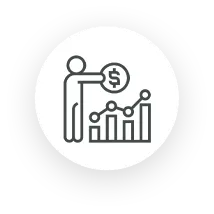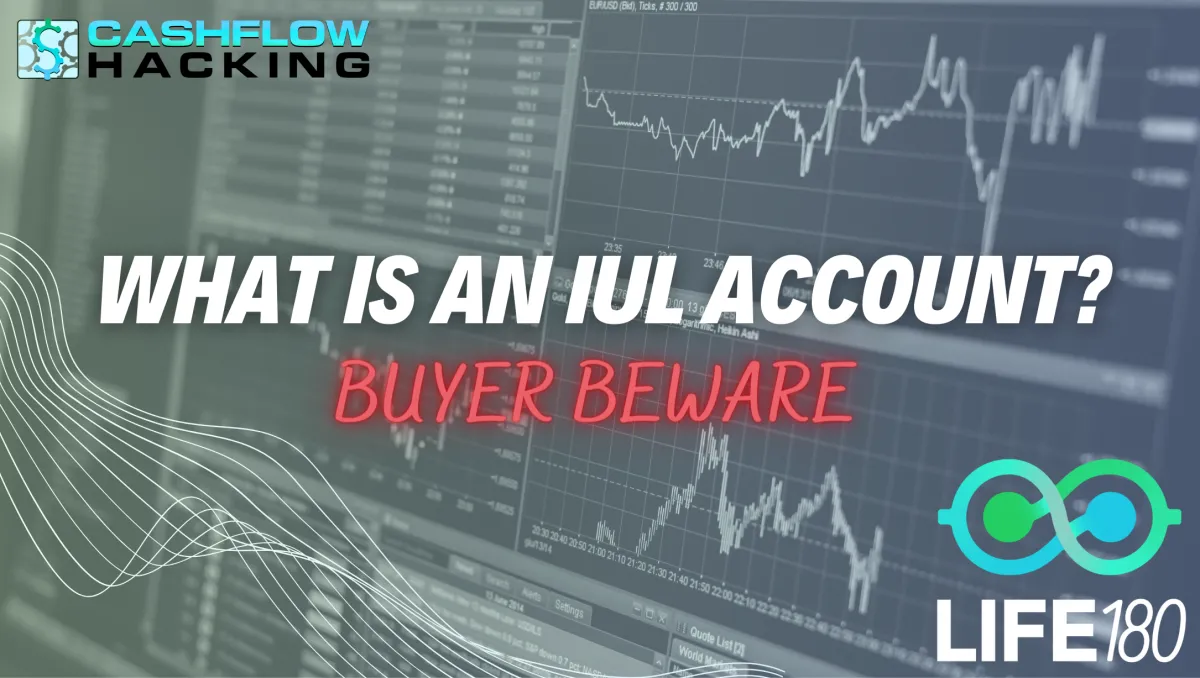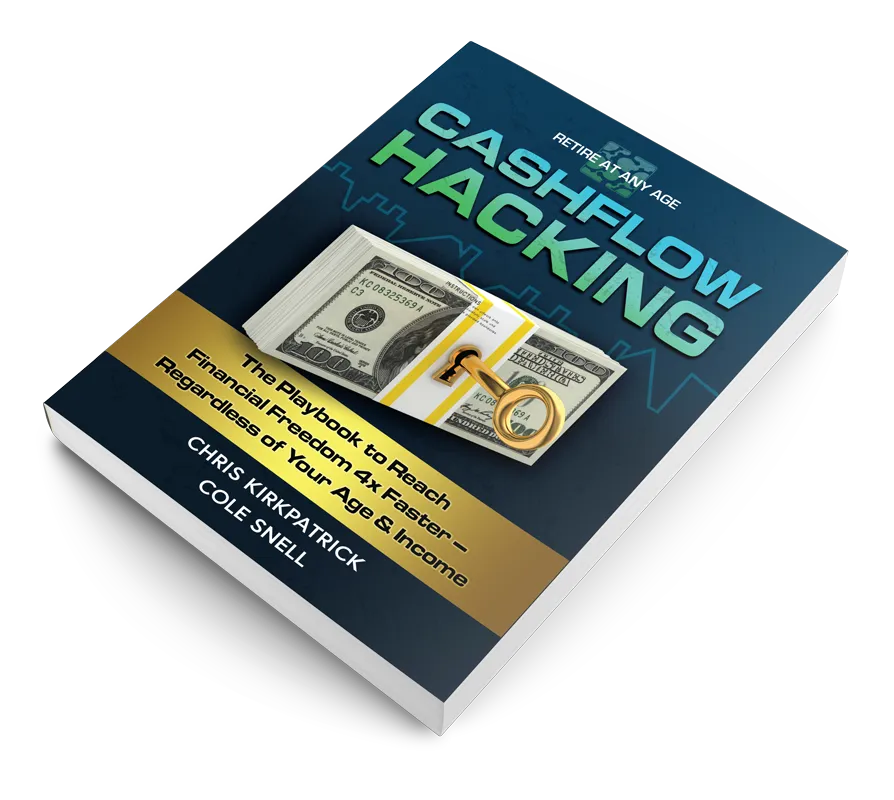
Simplifying Financial Confusion
LEARN CASH FLOW HACKING TO REACH FINANCIAL FREEDOM
Used by 90% of millionaires to reach their financial goals 4x faster

Achieve Financial Freedom Through Cash Flow Hacking

Increase Your Lifestyle While You Build Your Wealth

Position Yourself to Thrive in Market Downturn
YOU SHOULD NOT FEEL OUT OF CONTROL ABOUT YOUR FINANCIAL STRATEGY

Have easy access to your money in case of emergencies and opportunities

Use the investment strategy 90% of millionaires use

You deserve a clear plan to consistently grow your money and avoid market uncertainty

Have a guide and advisor that has your best interest in mind

Do not overpay in taxes

Stop guessing at the best vehicles to protect and grow your money

What Is An IUL Account? | BUYER BEWARE
The following text is an adaptation of the video content available on the LIFE180 YouTube channel.
The IUL, or Indexed Universal Life, account is gaining popularity, especially among influencers on platforms like TikTok, Instagram, and YouTube. It's being promoted as a compelling alternative for generating tax-free income in contrast to traditional 401(k) plans.
The core concept revolves around seizing control of your finances, steering away from government influence. Given the anticipated rise in taxes, the argument is to pay taxes upfront when contributing to an IUL account, allowing for tax-free income during retirement, a strategy purported to address various financial concerns.
In this article, we're going to go through all of this conversation, we're going to dissect the good, the bad, the ugly of it, and at the end, you're going to have a lot more clarity about what is an IUL account?, is it right for you?, and what other alternatives may be a good fit instead.
When it comes to IUL accounts, the terminology seems a bit misleading to me, as I don't view them as traditional accounts. Many individuals are positioning Indexed Universal Life (IUL) insurance policies as "IUL accounts," likely in an attempt to present them as alternatives to 401(k)s. Personally, I find this phrasing non-compliant and inaccurate. I wasn't even aware that the term "IUL account" was trending to such a significant extent. It's crucial to maintain accuracy and compliance when discussing financial products and avoid misrepresentations, even if certain terms gain popularity in search queries.
What Is An IUL, How Is It Sold, How Does An IUL Actually Work?
I felt a sense of responsibility to provide an educational article that genuinely explores what an Index Universal Life (IUL) account is. This article aims to offer clarity on the concept of an IUL account, delving into what an IUL is, its functioning, and the sales process. My goal is to provide a quick and accurate assessment of how IULs are sold, shedding light on crucial aspects that people need to be mindful of when navigating through this process. The intention is to empower readers with knowledge to make informed decisions regarding IULs.
An IUL account is essentially an IUL policy, not an account in the traditional sense. When it comes to how it's sold, the key features highlighted are upside potential and downside protection. The sales pitch revolves around the concept of participating in an index, which could be the S&P 500 or a proprietary index. The primary focus is on the promise of experiencing gains when the market performs well while having protection against losses during market downturns.
Upside Potential And Downside Protection?
The core idea behind an IUL account is to present a trade-off scenario to potential investors. The sales pitch involves asking people if they would be willing to cap their returns at, for instance, 10% to 12%. In exchange for this cap, they would benefit from a 0% floor, meaning they would be protected from market downturns, particularly those associated with negative 20%, 30%, or even 40% years.
The concept is to forego the potential for exceptionally high returns, such as those in excess of 30%, in order to avoid significant losses during market downturns. It's essentially a strategy that emphasizes steady, moderate gains with downside protection.
The prevalent sentiment among persons considering an IUL account is that capping returns at a moderate rate, like 12%, in exchange for a 0% floor is a favorable trade-off. Many believe that having a floor of 0% provides crucial protection against losses, emphasizing the idea that "zero is your hero." The emphasis on protection from losses aligns with the notion that avoiding downturns is as vital as pursuing high returns. However, it's essential to scrutinize this concept, as there are complexities involved.
While "zero is your hero" resonates with the idea of safeguarding one's investment, it's crucial to recognize that the cap on returns can be perceived as a trap. Understanding the intricacies of how caps and indexes operate reveals that investors might not have as much control over their money as they think. The interplay of these factors requires careful consideration to make informed decisions about utilizing an IUL policy.
Is An IUL A Good Alternative To A 401k?
The predominant selling point for these policies is positioning them as an alternative to a 401k. The argument goes like this: why stash your money in a 401k and defer taxes until later, especially when taxes are on the rise? From this perspective, the question becomes, why not pay taxes now and enjoy tax-free income during retirement with an IUL account? On this particular point, I find myself in agreement.
The idea of transitioning from a 401k to an IUL often stems from concerns about rising taxes. Advocates of IULs argue that by choosing this path, people can wrest control from the government, which would otherwise dictate the fate of their money in a 401k. However, it's crucial to understand that opting for an IUL means relinquishing control to an insurance company.
While some may downplay this shift, asserting the moral integrity of insurance companies, it's essential to consider historical instances, such as the Universal Life lapse issue spanning the 80s, 90s, and early 2000s. Delving into this history might reveal some eye-opening revelations about the practices of insurance companies during that period.
There's an excellent book titled "Lapsed" that delves into the intricate challenges faced by MetLife in relation to their index universal life, universal life, and variable universal life chassis platforms. The book thoroughly examines the systemic lapse issues within the company. I've recently acquired it and I'm currently reading it. While it provides fantastic technical insights, it may not be hyper-entertaining unless, like me, you find it infuriating and motivating to understand the misrepresentation of these products. Stay tuned, as I plan to have the author on my YouTube channel LIFE180, for further discussions.
Now, let's evaluate the options presented when considering an IUL. Salespeople often advocate for IULs over 401ks, emphasizing features like a cap and a floor. For instance, a plan might have a 12% cap and a 0% floor. Some argue for plans with no capped upside potential, boasting unlimited caps while maintaining a 0% floor. If this were a foolproof strategy with limitless gains and zero downsides, it would indeed be revolutionary. However, the reality is that there are inherent risks, undisclosed fees, and undisclosed factors in play, making it crucial to scrutinize the fine print and assess the true nature of these financial tools.
Levers Life Insurance Companies Can Manipulate In IUL's
In the realm of IUL, there are a few crucial factors to consider. We've got spread charges and multipliers, which introduce additional risk but enhance the visual appeal of the illustrations—a noteworthy point to keep in mind. Then, there are the no-risk rates, tied to 10-year bond rates. To simplify, if the bond rate is, let's say, 5%, a corresponding no-risk rate of 5% means the initial 5% of your policy's performance won't be returned to you; it all goes straight to the insurance company. That's quite a significant detail.
To summarize, we have spread charges, multipliers, no-risk rates, and participation rates. These elements represent various facets and mechanisms that life insurance companies can adjust. Furthermore, there are variables such as cost of insurance levels and administrative fees that can undergo changes.
Every company is a little bit different, works a little bit differently, but at the end of the day, on top of the cap rates, you have all these elements that can change and will change according to the insurance company as time goes on. And what's happened is I've been saying to people, IUL is just a failing financial experiment and I really, really caution people about putting money in there.
I understand the concern regarding the 401k discussion, and I agree that the landscape of taxes is a significant factor. Currently, we find ourselves in one of the longest periods of historically low tax rates. If we rewind to the inception of the Federal Reserve in 1913 when the tax code was introduced, the top tax rate was around 7%, primarily affecting the highest income earners. Over time, it skyrocketed to the 90% range. Even as recently as 1980, when 401ks were introduced, the top marginal tax bracket was 70%, a level we haven't seen since.
Reagan's presidency marked a shift when he reduced tax rates, and since the 80s, they have fluctuated but remained relatively low. It's essential to consider this context when evaluating the effectiveness of 401ks in the current tax environment.
When considering the broader economic landscape, including factors such as national debt and the prevailing trends, it becomes evident why the conventional wisdom of deferring taxes in a 401k may warrant reassessment. The concern lies in the foreseeable trajectory of taxes, seemingly on an upward trajectory, and the lack of control one has over their funds in a 401k.
For people currently facing a 35% tax rate, the prospect of a future increase to 50% introduces a significant financial challenge. This not only impacts the immediate financial situation but has profound implications for retirement planning. The inherent risk lies in the government's ability to levy taxes on accumulated wealth within a 401k, regardless of the total amount saved. What truly matters is not the gross amount but the net amount available to sustain one's lifestyle.
In the unpredictable realm of 401ks, where variables abound, the ultimate outcome remains uncertain. The effectiveness of these accounts largely depends on the numerous variables at play and the timing of one's retirement. Enter Indexed Universal Life (IUL), presented as a potential solution to this uncertainty.
However, the caveat is that the perceived solution of IULs introduces a new set of challenges. While aiming to address the unpredictability of 401ks, IULs place control in the hands of insurance companies. These entities have the ability to manipulate various levers, impacting the policy's performance. Notably, IULs emerged in 1997, yet from 1997 to 2009, they held minimal market share, indicating a period of evolving understanding and market adoption.
The History of Indexed Universal Life Is Tragic
If we reflect on the period from 1997 to 2009, it's noteworthy that Indexed Universal Life (IUL) products struggled to gain market share. This lack of traction can be attributed to the absence of a compelling narrative during that time; it just wasn't a standout option. However, in 2009, a narrative emerged emphasizing the dual benefits of upside potential and downside protection. Despite its potential, this story remained largely unnoticed, seen more as a marketing ploy than a substantial shift.
Fast forward from 2009 to 2022, and the performance of these IUL products tells a less-than-encouraging tale. Year after year, the numbers reflected a declining trend. Regulatory changes became imperative and occurred three times in 2015, 2020, and 2023, introducing AG 49, 49A, and 49B regulations. These changes aimed to curb the extravagant illustration numbers that painted IULs as exceptionally attractive. The question arises: Why did insurance regulators feel the need to intervene? The answer lies in the deceptive practice of agents presenting IUL illustrations as conservative, leveraging the perception of insurance companies as prudent entities.
The scenario often unfolds with agents marketing IULs, claiming their illustrations are conservative. This narrative appeals to consumers who view insurance companies as inherently conservative. I understand this perspective intimately; I, too, fell into this trap, selling IULs for four and a half years before gaining a deeper understanding. This personal experience fuels my current passion for educating people about the intricacies of these financial products and how they truly operate.
Ultimately, the narrative surrounding Indexed Universal Life (IUL) illustrations being conservative may seem logical, given the historical context of how insurance companies operate. However, a closer look at illustration updates in 2015, 2020, and 2023 reveals a different story. While these updates aimed to reduce illustration performance, IUL companies adeptly found workarounds, exemplified by a recent release in May 2023.
This constant evolution in response to regulation suggests a potential need for a comprehensive regulatory overhaul in the future. Many persons are experiencing significant challenges with their IULs not delivering the expected performance. It's crucial to clarify that I'm not asserting that IULs are incapable of performing; indeed, they can. However, the reality is that there's approximately a 5% chance that your IUL will align with the way it's marketed. This, to me, represents a significant concern. The product is presented as safe, predictable, and simple, yet in reality, it's complex, unpredictable, and carries the risk of financial loss.
The notion of earning uninterrupted compounding through indexing in an IUL policy is a common talking point. However, it's crucial to emphasize a clear understanding that investing in an IUL comes with the risk of losing money. This risk arises from market loss, when you deposit your money into the account, it goes into the general fund, where an option strategy is implemented.
The outcome hinges on the performance of this option strategy: if it succeeds, you earn based on the cap or the index's performance, depending on your chosen strategy. Conversely, if the option fails due to a market downturn, you incur losses equivalent to the option budget. In essence, this is a simplified explanation of the potential outcomes.
Many people may not be fully aware of the intricate dynamics at play in this scenario. I've created several articles and videos delving into the details of this game. I strongly recommend exploring my IUL Play Playlist, which is part of my training series available on the Youtube Channel Life180. I believe this resource will provide substantial value in educating yourself on these matters.
Use Life Insurance Companies For What They Do Best
In my perspective, the crux of the matter is that persons attempt to leverage life insurance companies to achieve seemingly extraordinary returns that outshine the markets, all while covering the cost of insurance. The assumption here is that if insurance companies could genuinely deliver such exceptional returns, they would be unparalleled investors globally.
History has consistently demonstrated that this is not the case. The inability of insurance companies to achieve this has been evidenced throughout history. Consequently, regulators continually adjust regulations on illustrations, and companies persist in finding ways to navigate these changes.
It's a bit reminiscent of the days when the Feds were pursuing Al Capone, isn't it? He managed to evade them for a while, but eventually, he faced the consequences. Similarly, the hope is that our industry, along with many clients and policyholders, won't end up in a situation akin to Al Capone's - dead or in jail, and certainly not in a good spot.
I've seen numerous individuals significantly harmed by IUL policies, grappling with surrender charges, liquidity problems, market performance challenges, and policy design complications. While some argue that designing policies for minimum death benefit and maximum cash value can mitigate issues, I must emphasize that even with optimal design, there are too many aspects of the policy beyond your control. This uncertainty contradicts the reason for utilizing a life insurance company.
Let's take a moment to reflect on your financial goals. If you're in a position to advise or sell to others, consider the problem you aim to solve. Importantly, it's advisable never to assume unnecessary risks within a life insurance contract. The core strength of life insurance companies lies in securing safe returns, optimizing returns with minimal risk.
However, the challenge arises when life insurance companies are given the authority to use options and purchase call options within an Indexed Universal Life (IUL) chassis, particularly one employing an annual renewable term chassis. In doing so, you forfeit the advantages derived from the insurance company's expertise in securing safe returns, essentially diverting them from their proficiency. This shift puts them outside their area of excellence, eroding the benefits they excel at. It's a critical consideration when navigating the complexities of financial products.
It's akin to taking a highly skilled professional baseball player, perhaps a silver slugger, and then asking them to transition to playing running back in the NFL. The skills don't necessarily correlate between the two sports. In a similar vein, certain hedge fund managers and high-risk asset managers, like Ray Dalio, may excel in generating significant returns in their specific domains. However, expecting them to manage a general fund in the same manner might not be a seamless translation of their skills.
It's crucial to recognize that each company is meticulously designed and operates in a specific way to achieve distinct outcomes. For life insurance companies, their primary mission is to safeguard your money, deliver optimal returns with minimal risk, effectively outperform inflation over the long term, and provide returns reminiscent of bonds with tax benefits akin to municipal bonds. Additionally, they offer the liquidity characteristic of money markets.
When appropriately designed, having a segment of your portfolio allocated to this purpose can be truly advantageous. It's essential to highlight that life insurance, on its own, should never be misconstrued as an investment or utilized as such. However, when integrated correctly, it can serve as a valuable component within a broader and diversified portfolio.
The primary issue I observe with Indexed Universal Life (IUL), and there's more to delve into, revolves around the notion of it becoming an all-encompassing zero-sum game, an approach suggesting placing all your money into a single product. Prominent figures like Doug Andrew advocate for an approach where people are encouraged to invest as much as possible into this policy, believing it will address all financial concerns and result in substantial tax-free income in retirement. However, this perspective is far from accurate.
Embracing this approach can lead to significant challenges. Following such advice might result in a less-than-optimal financial outcome, leaving individuals with far less than anticipated at retirement and potentially jeopardizing their financial future. It's crucial to approach financial strategies with careful consideration and a diversified perspective.
When exploring your financial options, it's essential to carefully consider these aspects. Now, how can you effectively leverage life insurance companies to assist you?
How To Use Life Insurance To Increase Your Financial Success
I hold a strong affinity for properly designed whole life insurance because, unlike Indexed Universal Life (IUL) where you essentially become a profit center for the company, with whole life insurance, you become a business partner. As the insurance company achieves more success, you participate in that success through dividends. While it may not have the allure or excitement, it precisely delivers what I mentioned. It provides bond-like returns, addressing the need for a secure investment in our financial portfolio. Furthermore, it offers tax treatment akin to municipal bonds, which is quite advantageous, and money market-like liquidity. Consider the stability and benefits it brings to the table.
Consider this scenario: If you had the option of a high-yield savings account right now – a choice that might prompt some to question why they would invest in a whole life insurance policy earning 5% when high-yield savings accounts are offering a similar rate – it's essential to reflect on the historical context. Just two years ago, high-yield savings accounts were earning less than a percent. While they've currently reached a 5% return, the crucial question is what they will yield three, four, or five years from now.
Contrastingly, two years ago, whole life insurance consistently earned 5%. While high-yield savings accounts might seem competitively appealing in the short term, it's vital to recognize that short-term thinking does not address long-term financial challenges. This distinction is the key aspect I encourage people to contemplate seriously.
Consider your long-term planning carefully. Shift your perspective towards generating tax-free income during retirement. Instead of relying solely on life insurance for yearly income, incorporate it as a component of a more comprehensive strategy. This broader approach could involve real estate, various investments such as business ventures or stocks, and strategically allocating a portion of your retirement income to serve as a volatility buffer within a life insurance framework.
My recommendation for everyone is to maintain between four and six years of income in cash value within your whole life policy. This serves as a crucial volatility buffer. During market downturns, you can leverage the cash value in your life insurance policy as a source of income. This strategic move allows you to avoid liquidating underperforming assets for income, providing an opportunity for those assets to recover, as markets inevitably do.
Retaining a financial cushion in a whole life policy, available for tax-free income, allows your overall portfolio to perform more robustly. It shields you from the common scenario where retirees are compelled to draw income from their investments during market downturns, which can significantly impact their financial well-being. By strategically tapping into the cash value of a whole life policy, you not only benefit from tax advantages but also enable your other assets to rebound during challenging market periods. This approach optimizes the performance of your entire retirement portfolio, offering enhanced leverage and longevity without escalating risk. This is where the true value of life insurance shines.
While life insurance companies are generally beneficial, Indexed Universal Life (IUL) might not live up to its hype. If you've been considering it, the narrative you've encountered may be enticing, and I can relate to that. Listening to figures like Doug Andrew, I find myself agreeing with much of what he says, around 95% of it. However, the execution of the IUL product can be somewhat misleading compared to the portrayed benefits.
When I discuss life insurance, I refer specifically to whole life insurance leveraged as part of a broader plan. It's about comprehending how I intend to use it strategically within a larger framework, alongside my other assets in retirement. This involves using it as an emergency fund, a fund for my children's education, or even as a business capital reserve account. It offers immense flexibility and strength, making it one of the most potent and adaptable assets that many people are not fully aware of.
As with anything in the world, it's not a matter of good or bad; rather, it's about whether it aligns with your specific goals. Indexed Universal Life (IUL) isn't inherently negative if utilized according to its intended purpose. When IUL was introduced in 1997, its primary objective wasn't centered around tax-free income. This aspect emerged later in its life cycle as a marketing strategy to boost its appeal and sales, given its initial lack of market traction.
While the marketing narrative of upside potential and downside protection contributed to making IUL immensely popular, it has also proven to be one of the most disappointing products upon closer examination. The key lies in understanding its original purpose and evaluating whether it aligns with your financial objectives.
RescueMyIUL.com
That concludes our discussion. Should you have any questions or concerns, please don't hesitate to reach out. We offer a service called "Rescue My IUL," where you can go to rescuemyiul.com for a comprehensive evaluation of your IUL. Simply input all your relevant information, and we'll provide the assistance you need.
My team is committed to providing a thorough evaluation for you, offering a comprehensive breakdown. Unfortunately, we frequently witness these situations where these plans encounter significant challenges. It genuinely concerns us, and our passion lies in guiding persons toward the optimal solutions tailored to their specific situations. We'll offer the best possible guidance for your unique circumstances, whether that involves considering another policy, navigating surrender periods, or any other tailored approach. Every individual's situation is distinct, and numerous variables come into play, so our guidance will be uniquely tailored to your needs.
If you're seeking clarity on acquiring a policy and value education, we're here for you. Our clarity call is an opportunity for you to engage with one of my coaches, addressing all your inquiries. This isn't a sales call; its sole purpose is to empower you with knowledge. Whether you've read this article or watched several videos on my YouTube channel, if lingering questions persist, the clarity call is your chance to bring them forward. During this session, one of our certified professionals will assist you in finding the answers you're looking for.
If you have any questions, please feel free to leave a comment in the section below. I make a concerted effort to personally respond and engage with every comment on my channels. I don't outsource this task because I believe in maintaining a personal touch that others may not replicate as effectively. Your feedback and inquiries are important to me, so don't hesitate to reach out.
I hope you found value in this article. If you did, please consider sharing it with others. That's all for now. Until the next article, have a blessed and inspirational day.
HOW TO START TAKING CONTROL OF YOUR FINANCES BY MAXIMIZING YOUR CASH FLOW AND PROTECTING YOUR ASSETS

1. Schedule Your Free Clarity Call

2. Create a Free Customized Plan

3. Get Guide to Financial Success
GET YOUR FREE COPY TO STOP USING OUTDATED RETIREMENT STRATEGIES
Cash Flow Hacking teaches you to:
Protect Your Investments
Thrive in bad markets
Reach financial freedom faster

ARE YOU LOOKING FOR:

Cash Flow Hacking teaches you to:
Security to protect your money
Increased cash flow and lifestyle
Inflation protection
Financial certainty in all economic environments
A reduction in taxes
Safe and fast access to your money with no penalties
WHO IS THIS PROGRAM FOR?

People looking for an alternative
Are you looking for alternatives to Wall Street’s “buy and hold” strategy that takes 40 years with uncertain results? Our Cash Flow Hacking strategies provide you the building blocks to get started on the right foot

Passionate Entrepreneurs
Are you looking for a financial strategy that will take your best assets (you and your businesses) and multiply their potential? Our Cash Flow hacking strategies will teach you how to invest for the future without sacrificing building your business

Real Estate
Investors
Are you a real estate investor who is burned out from being a landlord or playing the fix-and-flip game? Our Cash Flow Hacking strategies will provide you with the system to create predictable wealth AND give you the freedom you are looking for.
YOU DESERVE PEACE OF MIND AND A PLAN THAT WILL PROTECT YOUR FAMILY AND GROW YOUR WEALTH
Today you need to be more savvy than ever if you try to go at it alone.
Losing money to inflation, taxes, and just poor investment strategies is leaving you frustrated, feeling out of control and not knowing where to turn. To add to the problem, the market is flooded with advisors who have outdated advice that does not place your best interests first, but instead focuses on charging you a fee that creates guaranteed cash flow for them.
NOT YOU
We believe this is wrong and that your security and best interests should be placed first. We believe you should be in a position where you control your money, your money doesn't control you. We understand because we talk with hardworking people everyday that are losing money in the markets based on old information and feel like they are guessing at the best course of action.
We created the Cash Flow Hacking plan to help you have security and control of your money to take advantage of life's opportunities because you deserve peace of mind with your wealth. The old way of planning for retirement of… Go to school Get a job & save as much as you can in your 401k and mutual funds...is broken.
You have been lied to. Think about it, where else in life does someone tell you that the most certain way to achieve your desired result is to take on more risk? The math just doesn't work, and the results are showing in our country and world. Did you know that 90% of millionaires in the United States have 1 asset in common?
Hint: it's not stocks or mutual funds (and no...it's not crypto) How much sense does it make for you to work hard, save money, reduce your current lifestyle (because that's what you are doing when you save for the future - taking money you could use on lifestyle today and delaying gratification to a future unknown time), and hope that whatever you are doing will work three to four decades from now? If you're thinking, "not much sense at all…", you are in the right place.
With over 50 years of experience on our team, we have worked with thousands of individuals and families to achieve financial freedom faster and with more predictability by helping them invest for Cash Flow.
How does the Cash Flow Hacking Plan work? 1. Take the Cash Flow Hacking Challenge 2. Complete the LIFE180 X-Ray and determine what your Freedom Number is 3. Work with a Cash Flow Hacking expert to provide you a customized plan
The customized Cash Flow Hacking plan will give you clarity on where you are now, where you want to go (and in what time frame), and what you need to do to get there predictably.
We value and commit to you: We believe you deserve the best financial education and guidance We believe financial decisions should not be rushed but be well thought out with a plan We believe you should be in control of your money We believe we earn your trust through time, education, and proper due diligence Without a proper plan and guidance, your money can be lost to taxes, inflation, and bad investments You deserve more with the most up-to-date strategies to mitigate your risk, control your money, and earn stable returns regardless of the market Schedule a call here to attain your LIFE180 Financial X-Ray now or get started with the Cash Flow Hacking Challenge for free.
I am interested in...